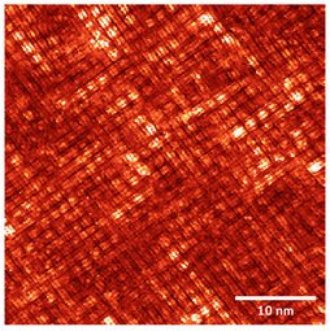Feb. 8, 2008 Research Highlight Physics / Astronomy
‘Virtual’ reality check for superconductors
New clues important to our understanding of superconductivity are provided by precise measurements of electronic states
 Figure 1: Periodic variations of the electronic states at the surface of a superconductor. The actual quasiparticle signatures are embedded in signals originating from unrelated surface effects and need to be filtered out using mathematical techniques. © Nature Physics/ Nature Publishing Group/ 3/ 868 (2007)
Figure 1: Periodic variations of the electronic states at the surface of a superconductor. The actual quasiparticle signatures are embedded in signals originating from unrelated surface effects and need to be filtered out using mathematical techniques. © Nature Physics/ Nature Publishing Group/ 3/ 868 (2007)
Researchers at RIKEN’s Discovery Research Institute in Wako, in collaboration with researchers from Cornell University in the US, and Kyoto University, have refined a method that measures small electronic excitations in superconductors. Comparisons of these properties for different materials have provided valuable clues towards our understanding of superconductivity.
The classical theory of superconductivity describes the superconducting state arising through the pairing of electrons into pairs. The properties of these electron pairs, however, are difficult to model mathematically. Physicists therefore prefer to describe them as a virtual single ‘quasiparticle’. “Although these quasiparticles are fictitious, they really govern the electronic states of superconductors, particularly at low energies,” explains Tetsuo Hanaguri from the research team.
Many details of the electronic states of quasiparticles and the precise amount of energy it takes to break up the electron pairs are difficult to measure, and remain poorly understood. This ‘break-up energy’, referred to as the ‘superconducting gap’, is traditionally considered as being directly related to the critical temperature where superconductivity persists. The larger the gap, the greater the difficultly to break up the electron pairs, thus the higher the critical temperature is for superconductivity. However, this relation has never been confirmed for the so-called ‘high-temperature’ superconductors, whose mechanism of superconductivity remains a mystery.
Reporting in the journal Nature Physics1, the RIKEN researchers have now measured the properties of the quasiparticles using a scanning tunneling microscope that scans the surface of a superconducting material with an atomic resolution and records tiny variations in the electronic structure (Fig. 1). However, the observed periodic variations in the electronic properties are difficult to analyze as a number of effects contribute to these regular patterns. Therefore, Hanaguri and colleagues developed a novel mathematical technique to successfully pick out the quasiparticle signatures.
This mathematical technique allows the researchers to characterize several materials and compare their superconducting properties. Surprisingly, the relative variation in the superconducting gap was found to be the same for two different high-temperature superconductors, although their critical temperature differs by a factor of three. This shows that, contrary to conventional assumptions, the superconducting state is influenced by more than just the size of the superconducting gap.
To better understand the relation between superconducting gap and superconductivity, Hanaguri says that further measurements are needed to determine the effect of temperature and magnetic field on the quasiparticles. Ultimately, these measurements may provide vital clues on the fundamental mechanisms governing high-temperature superconductors.
References
- 1. Hanaguri, T., Kohsaka, Y., Davis, J. C., Lupien, C., Yamada, I., Azuma, M., Takano, M., Ohishi, K., Ono, M. & Takagi, H. Quasiparticle interference and superconducting gap in Ca2–xNaxCuO2Cl2. Nature Physics 3, 865–871 (2007). doi: 10.1038/nphys753
